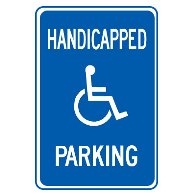We, humans (at least the ones in Western Civilization) have a tendency to take a good idea, implement it, then forget its purpose and finally betray its intention. One of those good ideas was brought forth by the American Disabilities Act of 1990.
ADA is a wide-ranging civil rights law that prohibits discrimination based on disabilities and it also ushered in a really thoughtful ordinance to create Handicapped Parking. These spaces are located closer to entrances of businesses, shopping centers, churches, banks and just about anywhere people park.
 Every state differs in their application of this national ordinance, but essentially all follow the guideline of “parking a vehicle carrying a person whose mobility would be otherwise significantly impaired by one or more of age, illness, disability or infirmity.”
Every state differs in their application of this national ordinance, but essentially all follow the guideline of “parking a vehicle carrying a person whose mobility would be otherwise significantly impaired by one or more of age, illness, disability or infirmity.”
But, this is what has happened, as it does with nearly everything we get our hands on: We expand the parameters, partly from our desire to be inclusive, but also because of our nature to be included, and by doing so we often facilitate abuse.
That is not to say that everyone using a placard who’s mobility isn’t significantly impaired is abusing the system, but it is to say that the system now works to its own detriment and if we don’t understand and enforce the original parameters the stage is set for abuse.
http://www.sfgate.com/bayarea/article/Abuse-of-disabled-placards-free-parking-persists-3684755.php
This essay started after I observed something and shared it on Facebook. I was walking from the grocery store to my car in a crowded lot and as I walked by a car in a handicapped parking space, a mother and her daughter jogged to the car, carrying bags, and jumped over a puddle toward the doors.
I have a friend in a wheelchair who has voiced his frustration when all the spaces are filled (“I hardly ever see other people in the store who can’t walk,” he notes), and I’ve heard several people share their disgust over clear cases of “Placard Fraud” and so I shook my head at the mother just as she glanced up to see me. She then pulled her placard off of her rear view mirror and said, “I have a handicapped tag, so there!”
I received her tone to be that of someone who was caught in the act of cheating. Should someone who can run and jump really be all that surprised if they are questioned in a handicapped parking space?
She called me a jerk and sped off through a lot crowded with pedestrians.
I posted this experience on Facebook, because I like using social media to start a conversation, and quickly received several “Thumb’s Up.”
But soon the tables turned….
“I am appalled by your insensitivity!”
“How can you judge that she didn’t have an affliction you couldn’t see?”
Great people, all of them, but they were incensed by my “insensitivity” and couldn’t believe that I hadn’t considered a possible “invisible” handicap. Some included me within the spectrum of discrimination against people with disabilities because, in their view, even circumstances that do not include challenged mobility should be entitled to parking convenience.
Or, perhaps, they believe that abuse is insignificant and should be overlooked in order to allow for the latitude.
If that were true, I may have conceded, but it isn’t. Even when I pointed out that this use of the space could be causing someone in a wheelchair, an elderly person, or someone at risk when walking, to have to park farther away, they did not buckle. Nor did they when I pointed out that it was the athleticism of the mother and daughter that caught my attention. Nothing I offered was compelling enough to consider that the intention of handicapped parking was for people who can’t run and jump to their car.
I genuinely understand the cause of their generous and inclusive nature, but I, too, did not move from my premise: By extending this to everyone who may fall under the umbrella of a helpful ordinance, we lose the original intention and open the door for misuse and fraud; which, in turn, hurts the people the law was designed to help.
There are many kinds of disabilities, some are obvious, some are not, some are physical, some mental, some both or none of the above. All should be given equal attention from a compassionate society, but no progress is made if we offer the same solutions to different challenges.
Handicapped parking was an effort to shorten the distance from a vehicle to an entrance so that people who cannot walk without pain or without assistance would not have to walk as far.
There is another aspect to this, as well, and it reverberates at the core of this “controversy.” That is the fact that it is undeniable that people abuse the handicapped  parking ordinance. Criticism of those taking advantage of convenient parking by using the placard of someone who legitimately possesses one, does not deny the struggle of those with challenges that are not evidenced by wheelchairs or with canes. Rather it supports appropriate actions so that the intentions of one provision don’t compromise another.
parking ordinance. Criticism of those taking advantage of convenient parking by using the placard of someone who legitimately possesses one, does not deny the struggle of those with challenges that are not evidenced by wheelchairs or with canes. Rather it supports appropriate actions so that the intentions of one provision don’t compromise another.
The arrogance of selfishness when people think that rules only apply to others, galls me, and I will take the these lumps for the times when I may be wrong. What I will not be is passive and look away from abuse just to avoid the conflict. That has far more sinister consequences.